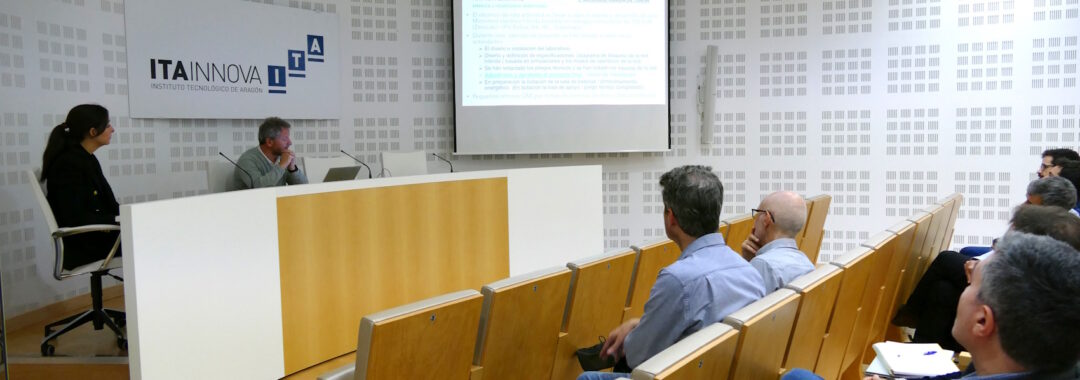The Aragon Green Hydrogen Complementary Plan will deploy all its equipment this year. From this spring, an improved hydrogen plant in Walqa, and from summer, in ITAINNOVA, a Zero emissions laboratory and a tractor unit to test this energy.
At the end of last year, the Aragon Institute of Technology hosted the progress review meeting of the Aragon Renewable Hydrogen Complementary Plan, with the participation of the technical teams of the project executing entities: Aragon Hydrogen Foundation, University of Zaragoza and Aragon Institute of Technology.
During the session, they presented the technical advances corresponding to the second year of execution in the different Lines of Action in which they are participating, covering the value chain: hydrogen generation, storage and supply and final use of hydrogen in heavy transport.
ITAINNOVA highlighted the advances that will be visible in its facilities by mid-year, such as the Zero Emissions laboratory aimed at optimising the management of hybrid networks with a high penetration of renewables and various energy storage systems for managing surpluses and balancing supply and demand; and the fuel cell electric tractor unit (FCEV), which is expected to provide a laboratory for demonstrating the viability of this technology, as well as for testing new components for this type of transport.
Aragon Institute of Technology
On behalf of ITAINNOVA, María García Camprubí, Scientific Coordinator of the Aragon Hydrogen Complementary Plan, informed those present that all the bidding processes required for the start-up of the demonstrators have already been completed. Thus, the Zero Emissions laboratory, aimed at optimising the management of hybrid grids with a high penetration of renewables and various energy storage systems (batteries and hydrogen) for managing surpluses and balancing supply and demand, is expected to be operational in summer 2024. The tractor unit and other equipment for the FCE-truck demonstrator will be delivered in summer 2024. This was conveyed to the team by both the scientific coordinator and the head of ITAINNOVA’s Sustainable Electric Systems team, Fernando Arteche. In the meantime, the fine design activities continue, as well as the generation of the digital twins of both facilities. The demonstrator is completed with an activity on the design and optimisation of the hydrogenerator network in Spain.
The first results of the multi-scale numerical methodology for the simulation of SOEC electrolysers, obtained thanks to the use of high-performance computational resources of the HERMES cluster (ICTS), were also presented. They showed the first prototype of a V-type tank for compressed hydrogen storage and the approach of the structural monitoring activities (SHM) that will start this year.
Aragon Hydrogen Foundation
The Aragon Hydrogen Foundation has completed the installation of the new equipment for the demonstrator for the optimisation of electrolysis processes in renewable energy plants dedicated to the production of green hydrogen, and will shortly start up the installation and testing. As for the upgrade of the Walqa hydrogen plant (700 bar), the facility is expected to be operational in the spring of 2024.
University of Zaragoza
The teams of professors José Ángel Peña, Emilio Larrodé, Javier Ballester, Norberto Fueyo and Antonio Valero presented their respective advances.
José Ángel Peña’s team presented the first experimental results of catalysts for the production of synthetic natural gas from biogas and electrolytic hydrogen. Emilio Larrodé, who collaborates with ITAINNOVA on the tractor unit, showed the initial results of the tool they have developed to evaluate the consumption of the demonstrator truck. Javier Ballester’s team showed the experimental facility they have set up to study the flames of CH4/H2 mixtures, while Norberto Fueyo’s group has completed the numerical study of the propagation of deflagrations of hydrogen/air mixtures. Finally, Antonio Valero’s team showed advances in modelling for the optimisation of the configuration of renewable ammonia production plants.
This Complementary Plan belongs to the Recovery, Transformation and Resilience Plan, which outlines the roadmap for the modernisation of the Spanish economy, the recovery of economic growth and job creation, for the solid, inclusive and resilient economic reconstruction after the COVID-19 crisis, and to respond to the challenges of the next decade. This Plan will receive funding from Next Generation EU funds, including the Recovery and Resilience Facility.
This action is co-financed under the Complementary Hydrogen Plan Agreement: 65% by the Recovery and Resilience Mechanism, framed within the “RECOVERY, TRANSFORMATION AND RESILIENCE PLAN – FINANCED BY THE EUROPEAN UNION – NEXTGENERATIONEU” and the rest is co-financed by funds from the Autonomous Community of Aragon. The expenses assigned to the MRR projects are financed at a rate of 100%.

